| |
|
St Giles,
Colby
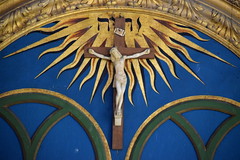 |
|
If
you take the great swathe of Norfolk that runs
from Fakenham to the east coast, taking the gap
between Cromer and Aylsham, you pass through no
towns. There are no medieval churches that Simon
Jenkins saw fit to put in his premiership in
England's Thousand Best Churches, and yet you
will find as many medieval churches in this
narrow band as most English counties have in
total.
Given that Norfolk has so many churches,
certainly more per square mile than anywhere else
in western Europe, it might be thought that to
visit even all those in this swathe would be a
hard slog. But this is not the case. Almost all
of these churches are kept open, or are at least
accessible. Many of them are lovely, and some
have wonderful things to see. And just a few are
of great interest, but little known, perhaps
because there are so many churches here. |
St Giles,
Colby, is a great case in point. Set awkwardly north of
its village along a lane going nowhere in particular, an
indeterminate number of miles south of Sheringham, it is
interesting to look at, it is beautiful inside, and it
has several extremely interesting features. I doubt that
it will be found in many people's top fifty Norfolk
churches - it is certainly in mine.
Externally,
it is rather odd. The tower is pencil thin, which in East
Anglia always starts you humming and hawing about the
Normans, but that is not the case here, I think, for it
looks all of its late 13th century origins. Then, there
is a massive late 15th century south porch, with image
niches and wonderfully carved spandrels. That on the east
side is clearly St Michael dispatching a dragon. Another
dragon is being dispatched on the west side, and this is
claimed by the guide books as St George. I wonder. He
carries no shield - St George usually carries a shield.
He is on foot - St George is usually shown on horse back.
There is something very similar on the porch at St
Michael at Plea in the centre of Norwich. Perhaps he is a
wild man, albeit a civilised one. Perhaps, more likely,
he is the donor of the porch, emulating his saintly hero
in the other spandrel by dispatching evil.
The porch lets straight into the nave, for there is no
aisle, no clerestory. You wonder if there is one around
the north side. You set out around the church, and are
met with a bit of a surprise, for the whole northern side
of the church has been rebuilt in 18th century brick.
Perhaps they did remove an aisle, but as you head east
you see that they also rebuilt the chancel in its
entirety.
This, then, is the skin. Perhaps it suggests what we
might find inside, 13th century origins that have not
been overwhelmed. A late medieval donor, pious and rich
enough to provide the porch, but not to add clerestories
or aisles - or, at least, not aisles that would last. An
18th century enthusiasm that was strong enough to rebuild
in confidence. Perhaps, also, there is a further
impression, that this is a parish that has had to
maintain and beautify its church by the graft of its own
hands - the key, for instance, the idiosyncratic work of
some early 19th century blacksmith.
Your first step inside will reveal all of these at once.
Light streams into the church through a simple Y-tracery
west window. The font is late 15th century, and topped by
the early Victorians in a rural manner. The 18th century
provided the view to the east, of which more in a moment.
In a county of interesting fonts, Colby's is one of the
most interesting. It is set curiously. It stands so that
no panel faces east, south, west or north; rather, being
off-centre, the two easterly panels face east-south-east
and east-north-east. It may have been moved, but the
pedestal it stands on does the same thing, and appears to
be original.
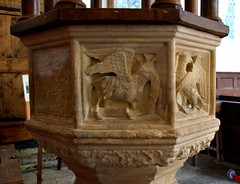  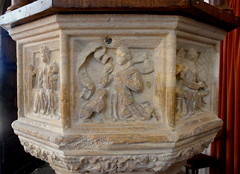 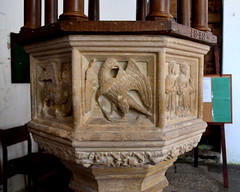
The most significant panel, and most
important, is that to the ENE. It shows the Madonna and
Child set in what I believe is known as the Seat of
Wisdom. Now, this is an extraordinarily rare image to
find on a font. It is undamaged by Anglican or Puritan
iconoclasts. The panels either side are also extremely
unusual. That two the south shows two kneeling figures in
15th century dress. They are paying homage, and are
almost certainly the two donors of the font. To the
north, another figure, a huntsman, kneels with an axe. In
front of him is what appears to be a small dog. This is
the figure of St Giles, who saved the life of a hind that
turned out to be Christ. We know that this church owned a
relic of St Giles before the Reformation - his finger, in
a silver reliquary.
All the panels are in super condition, and must have been
cemented over during the Anglican reformation of the
1540s. The other five panels are interesting for what
isn't there. The symbols of the four evangelists are
paired either side of the 8th panel. And this,
incredibly, is still cemented over. What on earth could
be beneath it? A crucifixion? A Holy Trinity? I couldn't
help thinking that it looked like 19th century cement, in
which case it was probably exposed by the Victorians at
the same time as the other seven panels, and then
cemented over again for being badly damaged.
Around the base of the font are reset brass inscriptions
that echo the font's evidence of 15th century important
people. And then, the view east is simple and delicious.
Not too much money was spent by the Victorians on the
nave - the walls are still panelled, the benches seemly,
the tiles restrained. There is no coloured glass.
And then, there is that gorgeous chancel - a small east
window above an 18th century sanctuary which is a rural
vision of what a City of London church might be like.
Even Moses and Aaron, flanking the now-removed decalogue
boards, are locally painted. It is claimed that this
reredos came from the church at Gunton on the occasion of
its rebuilding by Robert Adam. This may be so, but I find
it difficult to make the dates add up, and it does seem
to fit perfectly here. To top it all off there are some
fine 15th century glass figures reset in the otherwise
clear east window: Christ in Majesty and a Mary of the
Annunciation above the altar, two angels on their wheels
either side at the top, and other figures including St
James with his pilgrim staff and bag, St John with his
poisoned chalice and St Peter with his keys.
 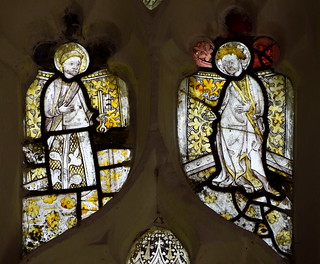 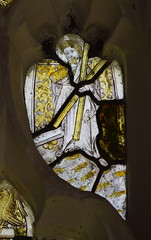
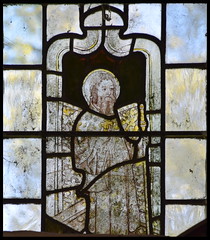 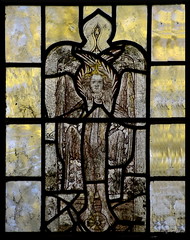 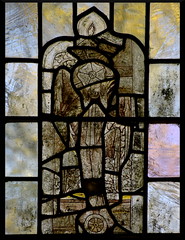 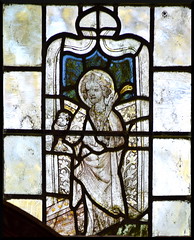
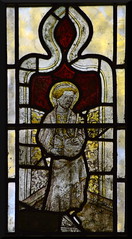 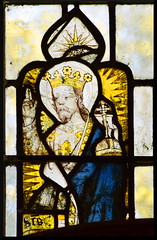 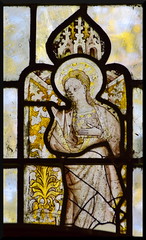
There is more of interest in this
immaculately well-kept church, including the inscription
to the 17th century Richard Snelling. He left one pound to
be distributed on every Christmas Day among the aged poor
of Colby, and ten shillings on every Easter Day to cloath
four poor children of the said parish. The altar
cloth in exquisite needlework set in a frame on the east
wall has an inscription recording that it was worked
by Miss Charlotte Coleby (1797-1869), elder daughter of
the Reverend George Coleby... by some means the
frontal passed into the custody of the Royal School of
Needlework, and it lay more or less forgotten until the
School moved to new premises in 1962, when it was
returned to this church. It is a rare and poignant
reminder of the Oxford Movement-inspired revival in the
Church of England as it was actually carried out by
people on the ground - it was, perhaps, the first altar
frontal that the parishioners of Colby had seen for
several centuries, and it is still here, in the place
where it was made and fondly used.
Simon Knott, August 2018
|
|
|
